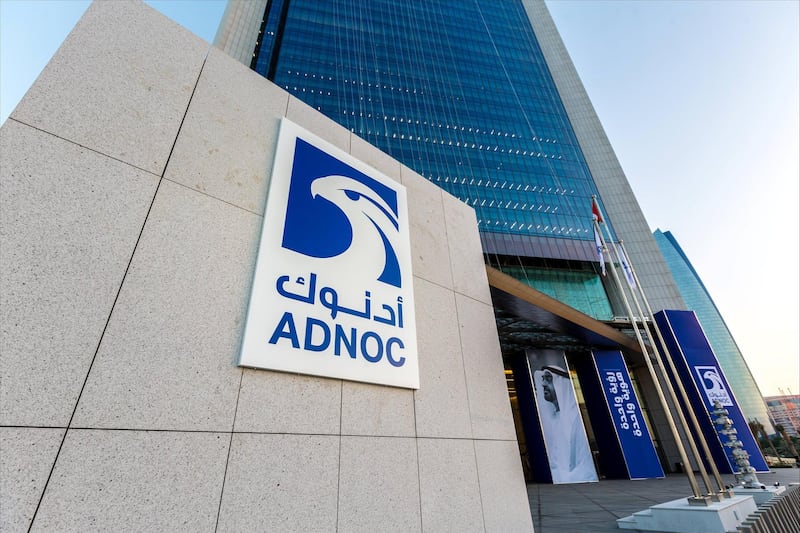For Abu Dhabi National Oil Company, the new year would chart the same course adopted in 2018 by most national oil companies in the Arabian Gulf, which is a significant pivot towards two streams viewed as more valuable than crude –gas and downstream.
Adnoc, which found itself busy in the first half of this year awarding concessions to international oil companies and launching its first licensing round, was occupied during the latter half shaping its strategy on boosting its refining and petrochemical capabilities and ramping up gas production.
While some of the major investment strategy decisions taken this year happened when oil prices rallied to three-year highs of $70 per barrel for Brent, it would be interesting to see which segment – downstream or gas – would receive the highest priority going into 2019.
Robin Mills, chief executive at consultancy Qamar Energy, noted that prioritising gas development would rank higher on the agenda for Adnoc, particularly as much of power generated in the UAE is gas-fired, with newer supplies likely to be fed into the domestic grid first.
“The gas strategy is very important, the oil licensing round is the third most important. I’ll put gas ahead in terms of the size of the economy and impact on the economy,” he said.
“The downstream could be scaled back if the market conditions change. However gas is critical to the power sector.”
Iman Nasseri, managing director, Middle East at consultancy Facts Global Energy (FGE) observed that the UAE, which is compliant with Opec output cuts, would continue to raise production capacity and commit to upstream spend, while at the same time rolling back output in accordance with the global oil pact. The Opec+ alliance, comprised of members of the oil exporters group and producers led by Russia, agreed in December to trim output by 1.2 million barrels per day starting January, with a view to revisit the agreement in April.
“We forecast the UAE production to drop in January by over 100,000 bpd from October level (in line with Opec+ deal) and to remain flat at near 3 million bpd [for] the [whole of] 2019,” said Mr Nasseri.
Be it oil, gas or refinery projects, 2018 was certainly a year of upstream and downstream activity for the UAE, which accounts for 4.2 per cent of global crude production, much of it produced by assets owned and operated by Adnoc.
Upstream investment in expanding production dominated the first half of the year for the state-owned company – Adnoc awarded stakes worth a collective $8 billion (Dh29.38bn) on blocks offshore Abu Dhabi to international oil companies, as it split the Adma-Opco concessions, since renamed Adnoc Offshore, while retaining a 60 per cent share.
Energy companies from China, India, France and Italy were all awarded stakes offshore, as Adnoc balanced the need for expertise in developing its resources with engaging with its major off-takers from the East. Most of the concessions were for 40-year terms, ensuring Abu Dhabi had consistent market share for the foreseeable future.
Towards the second quarter of the year however, Adnoc had made its intention clear that it would look to leverage its crude resources downstream and invited global energy companies to invest in its refining hub in Ruwais.
_____________
Read more:
Abu Dhabi discovers large reserves as it targets gas self-sufficiency
Adnoc to invest Dh165bn with partners in downstream
Abu Dhabi could develop significant LNG export capacity by 2024
_____________
Adnoc announced at an investment conference in May that it would invest Dh165bn billion with partners in developing the world’s largest integrated refinery as well as a derivatives and conversions park that would act as a manufacturing hub on the back of the expanding facilities in Ruwais.
The investments, for which Adnoc said it would adopt a partnership model, will see current refining capacity increased by 922,000 bpd to 1.5 million bpd. The capacity increase would outscale the world’s largest refinery, the 1.24 million bpd facility located in Jamnagar in the western Indian state of Gujarat.
Abu Dhabi’s state producer has also expanded its outlook on downstream investments, boosting capacity not only locally but also internationally. Adnoc and Aramco will jointly invest in a $44bn integrated refining in Ratnagiri on the west coast of India with a consortium of state-backed local refiners.
The investment comes amid an increasing shift towards securing the highly lucrative refining and chemicals sector in Asia. According to a report by advisory EY, Asia's market share of the global chemicals sector is expected to reach 64.6 per cent in 2030 from 61 per cent in 2015, driven by greater capacity expansion and rising consumer demand on the back of higher purchasing power in emerging economies.
Adnoc, also in May, offered six oil and gas blocks to international partners. Selected bidders are set to be revealed early next year, as the state oil company looks to increase production capacity to 3.5 million bpd.
The UAE’s production at the end of November stood at 3.25 million bpd, according to secondary sources cited by Opec.
The last quarter of the year witnessed further momentum upstream with Adnoc announcing large hydrocarbon discoveries, equivalent to a 1 per cent increase to existing oil reserves and a 7.1 per cent addition to proven gas reserves. It also raised investment spend to boost crude output capacity to 5 million bpd by 2030. With Abu Dhabi’s Supreme Petroleum Council’s approval of a Dh486bn five-year capital expenditure programme, the plan to develop the new discoveries could transform the UAE to a net exporter of gas.








